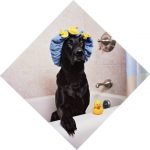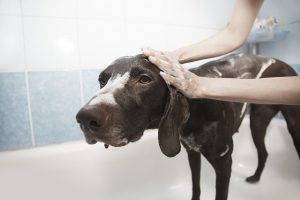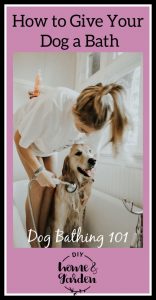Let’s be realistic, dogs can’t look and smell good on their own. As a pet parent, it’s your responsibility to keep your furry friend clean so that he gets to stay adorable and healthy for the rest of his life.
Why dog bathing is important to your dog
Bathing is a crucial part of pet care. For most dogs, the common reason to bathe is to get rid of any unpleasant odors or dirt on their coat. But for canines with particular skin conditions, bathing is an important part of the medical treatment recommended by the vet.
How often you bathe your dog varies as it’s usually required when your pooch has accumulated dirt on his coat or already has an unpleasant odor. Keep in mind that if you bathe your dog too often, it may end up drying his skin and coat which may also cause health problems.
Below are the steps you need to take to ensure the proper bathing and grooming of your pooch.

8 Steps to Giving a Dog Bath:
1. Train your pet to enjoy bath time
For a safe and enjoyable bathing time, teach your pooch to associate it with great rewards or something they love. Make sure to take things easy and slow so that your pet will feel relaxed and comfortable throughout the process. Give your dog plenty of praise and treats along the way to make every bathing experience a good one.

2. Prepare bathing and grooming supplies
Unless you have another person to hold the dog for you while you fetch the shampoo and other grooming supplies, it’s much better to prepare them ahead of time. Buy some dog grooming products in advance so that you have everything ready the moment your pooch gets dirty or starts smelling bad.
3. Remove any mats or tangles
Prior to bathing, brush your dog’s fur to remove any mats or tangles. You can also trim off mats or knots that you can’t resolve with brushing alone.
4. Wet your dog’s hair
Use clean water and wet your dog’s hair all the way to his skin. Work from his chest or neck area down to the back and sides, then towards his tail. If you are using a bathtub, allow the water to run down the drain so that it won’t fill up.
5. Use a washcloth
Use a damp washcloth to avoid wetting the head area. This way, you can take care to avoid the eyes, ears, mouth, and nose which are the most sensitive parts of a dog.
6. Apply shampoo and conditioner
Once the body of your dog is completely wet, apply an adequate amount of hypoallergenic shampoo. Begin at the chest area first then gradually move out to other areas of your dog’s body.
- Gently massage the shampoo onto your dog’s shoulder area, down to his sides, back,
front and back legs, then the tail. - Once your dog becomes comfortable, quickly wash his underside as this can be quite ticklish for some canines.
- After shampooing, gently rinse your dog with water using your fingers to make certain that you also get through your dog’s undercoat.
- If you want, you can apply a gentle dog conditioner following what you did when you shampooed. Depending on the type of conditioner you’re using, you may need to let it stay on your dog’s coat before rinsing it off completely.
- In case you plan on trying a new shampoo, make sure you do a patch test first to make sure there’s no skin irritation.
A dog bath doesn’t need to be a bad experience–for a pup or owner!
7. Wipe down with a towel
Although your dog may instinctively shake off excess water, you still have to help him dry off using a towel. After wiping down your dog’s fur thoroughly, you can allow him to air dry naturally. Avoid making use of hairdryers as they can be too hot, and most dogs dislike the sensation of air blowing at them as well as the sound.
8. Give a reward
Don’t forget to give some tasty treats right after bathing time to reward your dog for his calm behavior. Make it a routine to give rewards at the beginning and end of the bathing process.
This will help your pooch develop a love for bath time, making the experience enjoyable for both of you.
Your dog is all set and clean!
The challenge now is to help your furry friend maintain cleanliness. As much as possible, let your pooch stay away from dirt and train him to stay inside his pet home.



